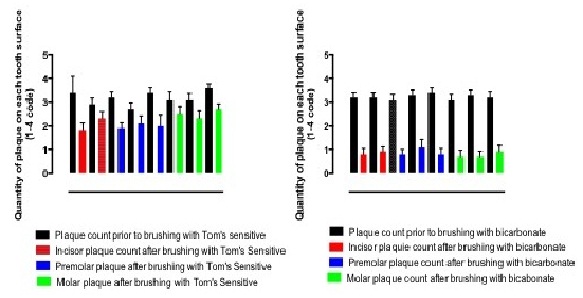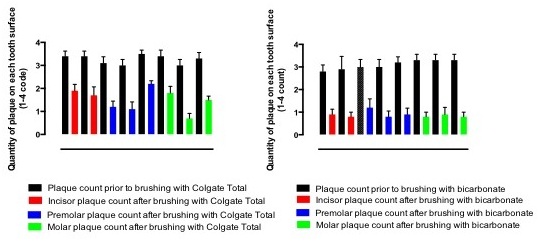





Published on Sep 12, 2023
The purpose of our experiment was to determine whether a range of commercially available toothpastes are better at removing plaque then our control (baking soda)
Plaque is a soft, sticky, and pale yellow film that naturally and continually forms and attaches to our teeth and gums. Plaque is composed of more than 1,000 different types of bacteria that break down food and produce acid as a metabolic byproduct. Plaque acid attacks the teeth and starts tooth decay by breaking down tooth enamel leading to cavities.
Plaque can also be found underneath the gums where the release of acid results in the tissue supporting the teeth breaking down, and the tooth eventually falling out. The main foods/ drinks that cause plaque are sweet drinks. Another one is candy. The frequently eaten food that causes plaque is complex carbohydrates. The more sugary and starchy foods there are on the teeth, the faster the plaque forms and spreads to cause harm.
Dentists recommend that people brush their teeth every 12 hours to easily remove plaque – after breakfast and before bedtime. This is because plaque that is formed within a 12-hour period isn’t bad enough to cause significant damage. However, once the plaque has built up over the course of many days then it becomes very dangerous for the teeth and can start to cause problems in the gums. If left to harden by not brushing your teeth it becomes tartar which is much more difficult to remove
There are quite a few common mouth diseases that are caused by plaque such as, gum disease, tooth erosions, gingivitis, periodontitis and many more. Gum disease is very serious, as it has been shown to result in heart attacks and strokes as a result of inflammation in the body. However, with diligent brushing to help prevent plaque and tartar formation, the teeth and gums can remain healthy for decades
Most of the plaque present on the teeth can be removed just with brushing. Many types of toothpaste are on the market and are used with the toothbrush to make brushing your teeth more enjoyable and to apply fluoride that strengthens the teeth. Many types of toothpaste also contain additional substances. These types of toothpastes contain various forms of grit, which is unfortunately very abrasive and can damage teeth and gums over a long period of use. This is counterproductive, as ideally brushing should not damage the teeth at the same time as cleaning them.
The purpose of our experiment was to determine whether a range of comercially availible toothpastes are better at removing plaque then our control, a baking soda mixture (baking soda and water).
This project is important to society because it is important for society to know which products arebest suitedfor them as an individual and which are harmful to themselves or to the environement.
IF the investigators brush teeth with baking soda THEN this will remove the same amount of plaque as more abrasive commercially available toothpastes.
Toothpastes: Crest Sensitivity Protection – Whitening + Scope, Colgate Total Clean Mint and Toms’ Sensitive.
Control: Baking soda mixed with water
Toothbrushes: Oral-B Complete Advantage - Extra Soft. A new toothbrush was used for each brushing.
For consistency brushing was performed by one student, Emily on each girl on three separate occasions. Approximately 2 days were allowed between each brushing to ensure that the amount of plaque on each tooth had returned to normal.
Each test subject started the clinical protocol by chewing on one disclosing tablet for 3 seconds to reveal plaque on they’re teeth. Thereafter, we measured the amount of plaque on 6 teeth on both upper quadrants of the mouth. The teeth studied were both the left and right top incisors, both the left and right top first precuspids, and both the left and right top first molars. The three teeth on the upper right quadrant were then brushed with each of the toothpastes (on seperate occasions) for 30 seconds followed by rinsing the mouth out with water. The quantity of plaque removed by brushing with each toothpaste was recorded using a visual coding system. To keep consistensy this was done by Samantha.
The coding system used was as follows
0 – no plaque remaining
1 – a small quantity of plaque that can be removed with a Q-tip
2 – plaque remaining on ¼ of the tooth
3 - plaque remaining on ½ of the tooth
4 – plaque remaining on ¾ of the tooth
The teeth of the upper left quadrant were brushed with our control baking soda. The teeth were rinsed with tap water and the quantity of plaque removed was coded as above.
At the end of the study, each girl had her teeth brushed with each of the commercial toothpastes.
Brushing with baking soda produced a great reduction in plaque. It reduced it to about a count of 1. Brushing with Toms’ Sensitive toothpaste only reduced plaque count to about code 3. Brushing with Colgate Total toothpaste only reduced plaque count to about code 2. Brushing with Colgate Sensitivity toothpaste produced the most effective results. It reduced plaque count to about 1, similar to the results of the baking soda.


The results we obtained with this experiment were very interesting. The two lower abrasive toothpastes did not remove a signifigant amount of plaque compared to the baking soda anf the Crest Sensitivity. There seemed to make a difference in the commercially available toothpastes as the more abrasive they were.
In these studies brushing with low abrasive sodium bicarbonate was very effective at removing plaque from all surfaces of the teeth. Sodium bicarbonate appeared more effective than the 3 commercially available toothpastes that were much more abrasive. Since the cost of bicarbonate is pennies and the other toothpastes cost money while grinding away the teeth and gums, it makes sense to use sodium bicarbonate regularly for brushing your teeth. It is acknowledged that the other toothpastes studied have additional ingredients such as sodium fluoride to strengthen the teeth and potassium nitrate to relieve sensitivity. However, sodium bicarbonate toothpaste does exist that contains fluoride but this brings the price back up to commercially available toothpastes. The studies shown here clearly show that bicarbonate is better than a range of more abrasive toothpastes at removing plaque.
Therefore our hypothesis is accepted we fully accept our conclusion. These studies studies further by repeating the experiments with the sources of experimental error provided earlier on in this report removed. We would also extend these studies by trying to find out which mechanism of the action of the bicarbonate is responsible for removing the plaque i.e. method of application, pH of plaque acid, sterilization of the bacteria by releasing oxygen etc. This information could help guide the development of new and more effective toothpastes.
Cohen, M. (2001). Analysis of Ordinal Dental Data. Jornal of Dental Research , 309-313.
Davenport, T. (n.d.). Top 10 Common Dental Problems . Retrieved October 22, 2012, from About.com: http://dentistry.about.com/od/toothmouthconditions/tp/10-Common-Dental-Problems.html
Elverne M Tonn, D. (2012, May 14). Tooth Plaque Causes, Preventions, and Treatements . Retrieved October 22, 2012, from WebMD: http://www.webmd.com/oral-health/guide/plaque-and-your-teeth
Periodontology, A. A. (n.d.). Types of Gum Diesease. Retrieved October 22, 2012, from Perio: http://perio.org/consumer/types-gum-disease.html